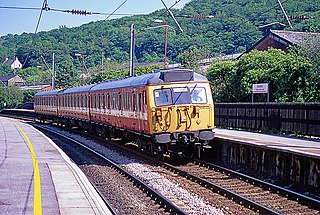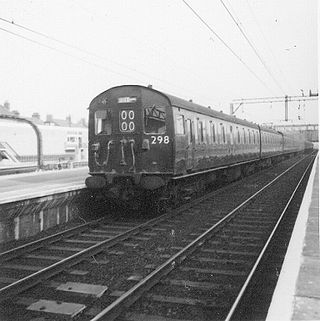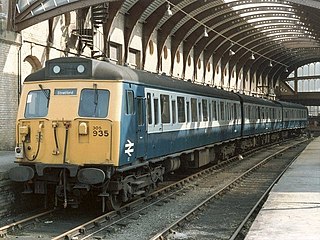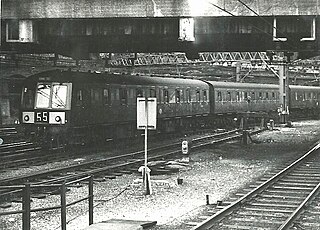
The British Rail Class 207 (3D) diesel-electric multiple units were built by BR at Eastleigh in 1962. The fleet had a lifespan of 42 years. The Southern Region class 201 to 207 DEMUs are nicknamed 'Thumpers' due to the noise their engine units make.

The British Rail Class 317 is an electric multiple unit (EMU) passenger train constructed by British Rail Engineering Limited in two batches: 48 sets were produced in 1981–82 and 24 sets in 1985–87. They were the first of several classes of British Rail EMU to be based on the all-steel Mark 3 bodyshell, departing from the PEP-aluminium design which had spawned the earlier Class 313 to Class 315, Class 507 and Class 508. The Mark 3 bodyshell was also the basis of Class 318, Class 455 and the diesel Class 150. The Class 317 uses overhead alternating current electrification. All units were withdrawn in July 2022.

The British Rail Class 308 alternating current (AC) electric multiple units (EMU) were built by British Railways' Holgate Road carriage works in three batches between 1959 and 1961. They were initially classified as AM8 units before the introduction of TOPS.

The British Rail TC multiple units were unpowered fixed formations of 3 or 4 carriages with a driving position at each end of the set, converted by BR's Holgate Road carriage works from locomotive-hauled Mark 1 carriages in 1966–1967 and 1974. The units built on experience gained from the prototype 6TC unit. In time the 3 car units were reformed into four car units to match the rest of the fleet and later classified as Class 442. This was later changed to Class 491, under which they spent the majority of their working lives. Shortly before withdrawal they were reclassified Class 438 and the units were renumbered to 8001-8034.

The British Rail Class 419 Motor Luggage Vans were battery electric multiple unit cars built from 1959-61 by BR at Eastleigh Works.

The British RailClass 303 electric multiple units, also known as "Blue Train" units, were introduced in 1960 for the electrification of the North Clyde and the Cathcart Circle lines in Strathclyde. They were initially classified as AM3 units before the introduction of the TOPS classification system, and were the dominant EMU on the Glasgow suburban railway network for over 25 years before being progressively phased out by newer rolling stock. The final units were withdrawn from service in 2002. The fleet's lifespan was 42 years.

The Inverclyde Line is a railway line running from Glasgow Central station through Paisley and a series of stations to the south of the River Clyde and the Firth of Clyde, terminating at Gourock and Wemyss Bay, where it connects to Caledonian MacBrayne ferry services. The line has been in operation since the 1840s between Glasgow and Greenock and was the first passenger service to follow the River Clyde to the coast. The line was electrified in 1967.

The British Rail Class 314 was a class of alternating current electric multiple unit (EMU) trains built by British Rail Engineering Limited's Holgate Road carriage works in 1979. They were a class of units derived from British Rail's 1971 prototype suburban EMU design which, as the BREL 1972 family, eventually encompassed 755 vehicles over five production classes.

The British Rail Class 504 was a unique type of electric multiple unit that ran on 1,200 V DC third rail with side-contact current collection. All other mainline UK third rails have the electric "shoe" on top of the rail. The type was used only on the Bury Line between Manchester and Bury. They were built in 1959 at Wolverton Works, and the body was a standard type used for several electrification schemes of the time, but the high DC voltage through a side-contact third rail was unique in Britain. The trains replaced the previous five-car units built by the Lancashire and Yorkshire Railway (LYR) for the route, which had inaugurated this electrification scheme in 1916.

The British Rail Class 318 is an electric multiple unit (EMU) passenger train which operates in west central Scotland. The units were introduced on 29 September 1986 as part of the electrification of the Ayrshire Coast Line between Glasgow Central and Ayr/Ardrossan with alternating current (AC) overhead lines. Their use was extended to Largs in January 1987. They were also used on the Inverclyde Line in small numbers. The trains currently operate Argyle Line, Cathcart Circle Line, North Clyde Line, Whifflet Line and Inverclyde Line services. Following the withdrawal of the Class 314 fleet in 2019, these units are the oldest working EMUs in Scotland, having been in revenue-earning service for more than 37 years.

Paisley Gilmour Street railway station is the largest of the four stations serving the town of Paisley, Renfrewshire, Scotland, and acts as the town's principal railway station. The station is managed by ScotRail and serves the Ayrshire Coast Line and Inverclyde Line, 7+1⁄4 miles (11.7 km) west of Glasgow Central. The station is protected as a category B listed building.

The British Rail Class 501 electric multiple units were built in 1955/56 for use on the former LNWR/LMS suburban electric network of the London Midland Region. A total of 57 three-car units were built.

The British Rail Class 306 was a fleet of electric multiple unit (EMU) trains introduced in 1949. It consisted of 92 three-car trains which were used on the Great Eastern Main Line between Shenfield and London Liverpool Street.

British Rail Class 503 passenger trains were 65 mph (105 km/h) electric multiple units. They were introduced in two batches: the first were in 1938, by the London, Midland and Scottish Railway (LMS), with a further batch in 1956 by the then nationalised British Railways (BR). When introduced by the LMS, they were known officially as Class AM3. They were designed for, and operated on, the Wirral & Mersey lines from Liverpool to West Kirby, New Brighton and Rock Ferry. There were few places on their network of closely-spaced stations to attain their maximum speed, except for the open section between Moreton and Meols. All but one set were withdrawn and scrapped by 1985. The final set was used on special Merseyrail services until 1988; it was preserved and kept at the Electric Railway Museum near Coventry, until it moved on to the Locomotive Storage Ltd warehouse at Margate.

The British Rail Class 302 was a type of electric multiple unit (EMU) introduced between 1958 and 1960 for outer suburban passenger services on the London, Tilbury and Southend line. This class of multiple unit was constructed using the Mark 1 bodyshell and was slam-door.

The British Rail Class 305 was an alternating current (AC) electric multiple unit (EMU). Under the pre-1973 British Rail numbering system, the class was known as AM5; when TOPS was introduced, it became Class 305.

The British Rail Class 502 was a type of electric multiple-unit passenger train, originally built by the London, Midland and Scottish Railway at its Derby Works. Introduced in 1940 and withdrawn by 1980, they spent the whole of their working lives on the electrified railway lines north of Liverpool.

Easterhouse railway station serves the Easterhouse area of Glasgow, Scotland. It was built by the North British Railway as part of their Coatbridge Branch and opened when the branch opened on 1 February 1871. The station is 5¾ miles (9 km) east of Glasgow Queen Street railway station on the North Clyde Line and is managed by ScotRail.

The British Rail Class 124 diesel multiple units were built by BR Swindon Works in 1960.

The British Rail Class 125 was a design of three car Diesel Multiple Unit built by BR Derby at Derby Works in 1958. They were almost identical in appearance to the Class 116.





















